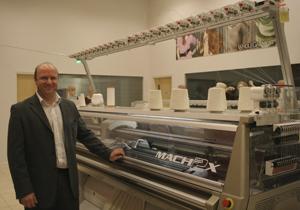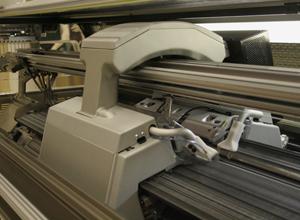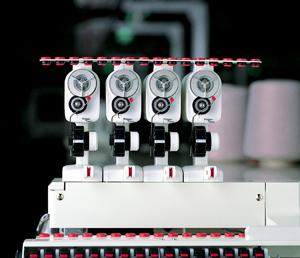 4 June 2009, Derby, UK – Pioneering manufacturer of advanced flat knitting machines for complete garment knitting, Shima Seiki Mfg., has reported early sales of its new MACH2X high speed Wholegarment knitting machine. The machine, which was launched at last year’s ITMA ASIA + CITME in Shanghai, is now on show at some of Shima’s subsidiaries and the company reports that it has already sold some 15 gauge MACH2X machines in Italy. We recently visited Shima Seiki Europe’s showroom near Derby, U.K. to get a close up view of the new machine.
4 June 2009, Derby, UK – Pioneering manufacturer of advanced flat knitting machines for complete garment knitting, Shima Seiki Mfg., has reported early sales of its new MACH2X high speed Wholegarment knitting machine. The machine, which was launched at last year’s ITMA ASIA + CITME in Shanghai, is now on show at some of Shima’s subsidiaries and the company reports that it has already sold some 15 gauge MACH2X machines in Italy. We recently visited Shima Seiki Europe’s showroom near Derby, U.K. to get a close up view of the new machine.
The MACH2X is based on Shima’s four needlebed SWG-X Wholegarment machine which incorporates the company’s own slide needle technology and is designed to knit high quality shaped Wholegarments which conform to the body for improved comfort and a more elegant silhouette.
The machine on show at Shima Seiki Europe’s headquarters was the MACH2 173X 15L, a 3-system (1 knitting system + 2 transfer systems), 170cm needlebed machine in 15 gauge (needles per inch). In this case the machine was fitted with L or large hook type needle, which will be explained later. The machine is available in gauges 12, 15 and 15L.
As the ‘MACH’ name suggests, the MACH2X is set apart by its running speed and subsequent high productivity. But it’s not just the impressive 1.6 m/s high running speed of the MACH2X that earns it its title.
Rapid Response
 The MACH2X is fitted with Shima’s R2 (Rapid Response) carriage, which features a new carriage mechanism combined with improved software programming that not only results in a maximum knitting speed of 1.6m/s, but just as importantly, the R2CARRIAGE achieves quicker carriage returns after each course. Shima says that, when combined, these improvements result in significant increases in productivity depending on the gauge and type of fabric.
The MACH2X is fitted with Shima’s R2 (Rapid Response) carriage, which features a new carriage mechanism combined with improved software programming that not only results in a maximum knitting speed of 1.6m/s, but just as importantly, the R2CARRIAGE achieves quicker carriage returns after each course. Shima says that, when combined, these improvements result in significant increases in productivity depending on the gauge and type of fabric.
Constant speed
Shima says that a major advantage of the R2 Rapid response carriage is that the quoted speed of 1.6 m/s is an actual speed whereas running speeds for SWG-X and SES series machines are quoted in average speed, with the SWG-X having a maximum speed of 1.3m/s and the SES range having a 1.2 – 1.3 m/s speed according to the model. This is because the R2 carriage almost eliminates the wasteful acceleration and deceleration phases of the carriage stroke, meaning that it is running at an almost constant speed of 1.6 m/s.
 When the MACH2X is set up on a new style the machine performs a warm up routine and the first piece is knitted at a speed of 1 m/s. Thereafter it is able to run at 1.6m/s. The MACH2X we viewed was knitting a sleeveless dress with fashioned neckline and straps. The fully-fashioned flared skirt had pointelle edging and was knitted using 2 ends of a 2/50s yarn, in 40%/ 60% rayon/ acrylic. The knit time was 28 min 22 secs, with the machine actually running at 1.6m/s for much of the time.
When the MACH2X is set up on a new style the machine performs a warm up routine and the first piece is knitted at a speed of 1 m/s. Thereafter it is able to run at 1.6m/s. The MACH2X we viewed was knitting a sleeveless dress with fashioned neckline and straps. The fully-fashioned flared skirt had pointelle edging and was knitted using 2 ends of a 2/50s yarn, in 40%/ 60% rayon/ acrylic. The knit time was 28 min 22 secs, with the machine actually running at 1.6m/s for much of the time.
Improving productivity
Although a deciding factor in the actual knitting time and productivity of the MACH2X will be strong even yarns, Shima has been thinking really hard about improving productivity. The MACH2X machine on show was a gauge 15L model, where the needlebed is cut 15 gauge but the needle hook is closer to that of a standard 12 gauge needle.
Although the 15L variant is a 15 gauge machine, it is aimed at the 12 gauge knitwear market and this specification is of high importance in improving productivity. This can be explained as follows:
For example if it is necessary to knit 120 needles on a 12 gauge machine with standard needles to yield a particular width of fabric, then the knitting area which the carriage has to cover is 10 inches (120 needles/ 12 needles per inch). On the MACH2X 15 L version, the same width of fabric can theoretically be produced with the same appearance by the carriage working over 8 inches (120 needles/ 15 needles per inch). Shima says this is an important consideration for customers who want to improve productivity.
High quality ribs
The MACH2X 15L version has another advantage when knitting 12 gauge Wholegarments. Knitting good quality tight ribs for the borders of high quality garments has always been an issue for flat knitters and Shima has constantly endeavoured to improve the rib knitting quality of its machines. By introducing more needles for a given width of fabric (15 needles per inch of needlebed instead of 12), the MACH2X 15L version allows the knitting of tighter ribs than was previously possible on a 12 gauge SWG-X machine. This will be of particular interest for knitters producing for top quality labels who will not tolerate the inclusion of elastane in ribs.
Another factor which gives the MACH2X its added productivity is Shima’s electromagnetic selection system which the company introduced on its SWG-X models. This allows for rapid needle selection which contributes to increased knitting speed and subsequently greater productivity. Shima says that its New Split Stitch technique also contributes by allowing more effi cient knitting by eliminating empty courses in some knitting sequences.
Intelligent digital knitting
 Standard on MACH2X are Shima’s well known DSCS, Digital Stitch Control System and the relatively new i-DSCS ‘with Intelligence’. Shima says that i-DSCS carries over the benefits of DSCS, with even better performance. Whereas DSCS is a passive system which controls stitch length and yarn tension by limiting yarn-feed, i-DSCS has the capability to actively control yarn-feed in both feed and retrieval directions as necessary, resulting in even higher quality and greater productivity using a wider variety of yarns, Shima says.Like DSCS, i-DSCS provides consistent quality across different production batches and repeat orders, and is crucial to the precision knitting required in Wholegarment production, the company adds. The machine on show at Shima Seiki Europe was fitted with a 3 encoder iDSCS on right hand side and an 8 encoder DSCS on the left hand side. The right hand side i-DSCS is used to drive the main body and sleeve yarns. The company says that the MACH2X will be able to handle more delicate yarns at high speeds because of active nature of i-DSCS.
Standard on MACH2X are Shima’s well known DSCS, Digital Stitch Control System and the relatively new i-DSCS ‘with Intelligence’. Shima says that i-DSCS carries over the benefits of DSCS, with even better performance. Whereas DSCS is a passive system which controls stitch length and yarn tension by limiting yarn-feed, i-DSCS has the capability to actively control yarn-feed in both feed and retrieval directions as necessary, resulting in even higher quality and greater productivity using a wider variety of yarns, Shima says.Like DSCS, i-DSCS provides consistent quality across different production batches and repeat orders, and is crucial to the precision knitting required in Wholegarment production, the company adds. The machine on show at Shima Seiki Europe was fitted with a 3 encoder iDSCS on right hand side and an 8 encoder DSCS on the left hand side. The right hand side i-DSCS is used to drive the main body and sleeve yarns. The company says that the MACH2X will be able to handle more delicate yarns at high speeds because of active nature of i-DSCS.
Additional features on the MACH2X, include a new control unit that is built-in to the machine for simplified shipping and installation, easier maintenance, and more efficient use of space. A USB memory interface and a backup power supply are also fitted as standard. The new machine also features a lower overall height for improved access to top tension units.
Wholegarment future for new production centres
According to Shima, the MACH2X is so productive that it is on average between 30% and 100% more productive than its SWG-X. If the machine proves itself to be as productive as Shima claims, then this is really an interesting development for the new production centres such as China. Generally speaking, to date the most sophisticated Wholegarment machines such as the SWG-X have been sold in Europe, USA and Japan. As labour rates in these countries are relatively high, manufacturers are forced to invest in the latest technology to stay competitive.
Until recently labour rates in China have been relatively low and investment in Wholegarment technology has therefore not been a serious consideration for most manufacturers. However, as labour rates rise and machines like the MACH2X offer greater productivity, we could well see serious interest in the technology from China. Shima says that the MACH2X is approximately 20-30% more expensive than the SWG-X and but that it already has enquiries for MACH2X for China via Hong Kong.
Some of the samples we viewed at Shima Seiki Europe were in fact able to be knitted in half the time on the MACH2X, when compared to the SWG-X. Some of the garments viewed were knitted in approximately 20 minutes on the MACH2X, which Shima says would have taken 40 minutes plus on the SWG-X.
Optional equipment for the MACH2X is Shima’s Air Splicer, for high-speed yarn splicing for precise colour changes in Wholegarment knitting. Unlike conventional knotting systems which mechanically tie together yarn ends, the Air Splicer cuts then twists together yarns with a burst of pressurized air with split-second accuracy. The system works in precise coordination with Shima’s i-DSCS to ensure that perfect colour changes can occur exactly as programmed.
Related News
Photos
More>>trade
market
- Vivienne Westwood Spring/Summer 2010 men's collection
- Versace Spring/Summer 2010 men's collection during Milan Fashion Week
- Milan Fashion Week: Spring/Summer 2010 men's collection
- Knitwit Goes "Green", Introducing Tofu Cashmere Fall 2009 Collection
- Giorgio Armani Spring/Summer 2010 men's collection during Milan Fashion Week





